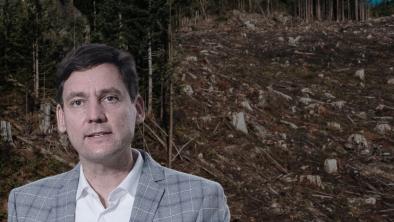Wetter weather could spell danger for Walbran

By Torrance Coste
Times Colonist
September 2, 2015
The rain that arrived last weekend was a welcome relief for the rivers and streams on Vancouver Island. But for one valley, the wet weather could be a wolf in sheep’s clothing.
The unusually hot, dry stretch that lasted most of the summer, combined with this year’s almost non-existent mountain snowpack, has left many Island rivers at record low levels, threatening returning salmon and other critical species that depend on them.
But it has also stalled industrial activity in the tinder-dry forests, including proposed clearcut logging in the ancient forests of the central Walbran Valley.
The Walbran, which sits just a few hours west and north of Victoria in unceded Nuu-chah-nulth territory, contains some of the most spectacular and ecologically important old-growth rainforest in Canada. In May, the Wilderness Committee learned that this tract of thousand-year-old trees is under direct threat of destruction by logging company Teal Jones.
The Wilderness Committee and other organizations have mounted a loud and vocal campaign, hosting rallies and public meetings, and organizing witness trips into the Walbran Valley. Thousands of citizens have written letters to the premier and to Forests Minister Steve Thomson, asking the B.C. government to deny logging permits in the central Walbran and look into alternatives with Teal Jones, local First Nations and other stakeholders.
Our requests for an emergency meeting with the minister of forests have been rejected.
To date, no permits have been issued for new cutblocks and Teal Jones hasn’t begun to clear the central Walbran.
Not yet, anyway.
In July, Teal Jones stated that its harvest operations were on hold for the fire season. How long it means to wait is unknown, but if the weather continues its swing toward more rainy conditions, the company could fire up the chainsaws soon.
Of course, any logging still has to be permitted by the government, and that’s where our role as citizens in a democracy comes in. Places like the central Walbran Valley, the last oases of old-growth among seas of clearcuts, are just too special to sacrifice.
It’s hard to explain what it’s like to walk among trees that were already hundreds of years old during Europe’s Dark Ages, or swim in the gin-clear Walbran River, the water of which is kept frigid through record heat waves and drought by the surrounding karst, rare limestone formations that underlie Teal Jones’ cutblocks.
From an ecological standpoint, the arguments for protecting what’s left of the Walbran Valley are endless. Old-growth forests provide critical habitat for endangered wildlife; they purify fresh water and stabilize steep slopes; they sequester far more climate-changing carbon than younger forests do.
Additionally, they contain traditional resources utilized by First Nations since time immemorial, provide opportunities for scientific research and serve as an irreplaceable resource for recreation and tourism — a vital economic driver on southern Vancouver Island.
On the West Coast, one of the most important steps we can take to combat climate change is to leave old-growth ecosystems intact. It would be heartbreakingly ironic to begin liquidating the Walbran on the heels of a summer dominated by heatwaves, record droughts, record low mountain snowpacks, high ocean temperatures and vicious wildfires, none of which are caused solely by climate change but all of which are events made more common and more intense by a carbon-dioxide-laden atmosphere.
We hope that as this year’s disastrous wildfire season begins to wind down, the forests minister will finally acknowledge the crisis in the Walbran Valley.
Over the past three months, we’ve heard from an unprecedented number of people concerned about the fate of the Walbran, many who have expressed willingness to blockade in the valley if that’s what it takes.
We need to radically reimagine forest management on Vancouver Island and across the province, with a priority on protecting those last few pockets of old-growth rainforest that haven’t been clearcut.
Scrapping it out valley by valley is too slow a process, and it puts in jeopardy forest ecosystems and the wildlife, indigenous cultures, forestry jobs and communities that depend on them.
Our government has a responsibility to find solutions to conflicts, to think ahead and conserve the best of B.C. for future generations. It doesn’t have a plan in place to protect what’s left of the old-growth forests, but that doesn’t mean it can continue to ignore the Walbran Valley.
Photo: Torrance Coste in the unprotected old-growth forest, Walbran Valley, Vancouver Island (Ty Jones)


